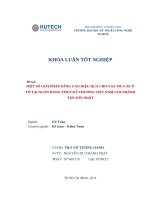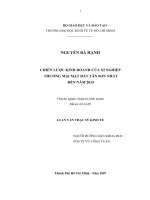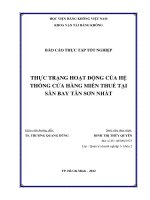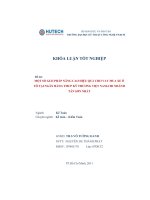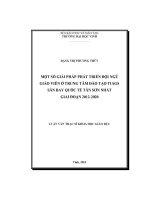Improving the baggage handling services at Tan Son Nhat international airport
Bạn đang xem bản rút gọn của tài liệu. Xem và tải ngay bản đầy đủ của tài liệu tại đây (689.4 KB, 52 trang )
i
Declaration
I declare that this master thesis is the result of my own research except as
cited in the references. The thesis has not been submitted before for any
other degree or examnination.
Huynh Thi Kim Thu
June 2014
ii
Acknowledgements
I am so much indebted to the love and support of the people around me.
Without you, this would have been a very difficult task.
I would like to express my deepest gratitude towards Professor Jacques
Martin for his guidance.
I sincerely thank my colleagues at Tan Son Nhat International Airport;
Vietnam Airlines and TIAGS.: Trong San Nguyen, Chi Kien Nguyen, Duc
Thanh Bui, Mai Nguyen, Duc Vinh Nguyen, Diep Thuy Vo and Thanh Tuan
Ngo for helping me completing this final thesis.
I also thank my husband for supporting me spiritually throughout the time I
had to concentrate on my master thesis.
iii
TABLE OF CONTENT
Declaration i
Acknowledgements ii
List of abbreviations and glossary of terms vi
List of figures x
List of tables xi
INTRODUCTION 1
CHAPTER 1. OVERVIEW OF THE BAGGAGE HANDLING AT TAN
SON NHAT INTERNATIONAL AIRPORT 2
1. BAGGAGE HANDLING PROCESS 2
1.1 Departure baggage handling process 3
1.2 Arrival and transfer baggage handling process: 3
2. BAGGAGE HANDLING SYSTEM 4
2.1 Check-ins 6
2.2 Barcode 6
2.3 Transfer offloads 6
2.4 Security Check 7
2.5 Conveyors 7
2.6 Sorting system: including primary sorting and secondary sorting 7
2.7 Oversize Baggage 10
CHAPTER 2. DATA CONCEPT 11
1.INTRODUCTION 11
2.BAGGAGE INFORMATION MESSAGES (BIM) 11
2.1 Baggage Source Message (BSM) 12
2.2 Baggage Transfer Message (BTM) 12
2.3 Baggage Processed Message (BPM) 13
2.4 Baggage Unload Message (BUM) 13
iv
2.5 Baggage Manifest Message (BMM) 13
3.BAGGAGE TAG NUMBER 13
3.1 Issuer Code 14
3.2 Serial Number 14
3.3 License Plate 14
3.4 Barcode 15
4.BAGGAGE GUIDANCE AND SORTING 15
CHAPTER 3. DATA ANALYSIS 17
1.INTRODUCTION 17
2.DATA ANALYSIS 17
CHAPTER 4. ANALYZING AND FINDING PROBLEMS IN SORTING
SYSTEM WITH FMEA METHOD 20
1.FAILURE MODES AND EFFECTS ANALYSIS (FMEA) 20
2.FMEA PROCESS 21
3.CHOICES MADE ON SCOPE AND ANALYSIS TOOLS 22
4.DATA ANALYZING 23
5.CORRECTIVE ACTIONS 28
CHAPTER 5. IMPROVING THE DEPARTURE BAGGAGE
HANDLING SYSTEM WITH RADIO FREQUENCY IDENTIFICATION30
1.RADIO FREQUENCY IDENTIFICATION (RFID) 30
2.COMPONENTS OF RFID 30
2.1 RFID Tag. 30
2.2 RFID reader 31
2.3 Supporting Infrastructure 31
v
3.BAG FLOW WITH AN RFID SYSTEM 31
3.1 Check-in 31
3.2 RFID Tag Reading 31
3.3 Transfer bag 32
3.4 Sorting system 32
3.5 Routing 32
3.6 Delivery to planes 32
3.7 Missing baggage sortation message (BSM) 33
4. PROS AND CONS OF RFID TECHNOLOGY 33
4.1 Pros of RFID 33
4.2 Cons of RFID 34
5.RFID AT HONG KONG INT‘L AIRPORT (HKIA) 36
CONCLUSION 37
REFERENCE 40
vi
List of abbreviations and glossary of terms
Abbreviations
Meaning
AMS
APR
BIM
BMM
BNS
BPM
BRS
BSM
BTM
BUM
DCS
HAN
FMEA
FS
HKIA
IATA
LAS
PNR
RF
RFID
RL
RPN
SGN
SYD
SITA
TIA
TIAGS
ULD
WLAN
IATA three-letter code for Amsterdam Schiphol Airport
April
Baggage Information Message
Baggage Manifest Message
Baggage Not Seen Message
Baggage Processed Message
Baggage Reconciliation System
Baggage Source Message
Baggage Transfer Message
Baggage Unload Message
Departure Control System
IATA three-letter code for Ha Noi – Noi Bai Airport
Failure Mode and Effects Analysis
Fault station
Hong Kong International Airport
International Air Transport Association
IATA three-letter code for Las Vegas McCarran Airport
Passenger Name Record
Radio Frequency
Radio Frequency Identification
Reason for loss
Risk Priority Number
IATA three-letter code for Sai Gon – Tan Son Nhat Airport
IATA three-letter code for Sydney Airport
Société Internationale de Telecomunications Aéronautiques
Tan Son Nhat International Airport
Tan Son Nhat International Airport Ground Service
Unit Load Device
Wireless Local Area Network
vii
Glossary
Airside - The secure area of the airport, as opposed to landside
Bag tag number - The number on a checked baggage is identified with 2
letters and 6 numbers.
Baggage handler - is a person who loads and unloads baggage (suitcases
or luggage), and other cargo (airfreight, mail, counter-to-counter packages)
for transport via aircraft
Baggage handling - The work of sorting, loading and unloading checked
baggage
Baggage Reconciliation - Baggage reconciliation is required by law and is
described as the linking of each piece of baggage with an accompanying
passenger before the baggage is allowed to travel. If bags travel
unaccompanied, they must pass further security checks.
Baggage tag – a document issued by carrier solely for identification of
checked baggage
Baggage Tag Issuer Code - This code combined with the tag serial number
are used to identify each piece of checked luggage through all baggage
handling processes. It is a three numeric identifier assigned by IATA. The
code is generally referred to as the BTIC.
Baggage Tray - Tray is used to convey rucksacks and small pieces of
baggage through the baggage sorting system in order to prevent them from
jamming on the conveyors.
Checked baggage – baggage that is transported in the hold of the airplane
as opposed to hand baggage.
Corrective maintenance Maintenance carried out after fault recognition and
intended to put an item into a state in which it can perform a required
function
Departure Control System - A computer system to execute check-in,
capacity control and dispatch of flights.
Downline Station - When baggage travels between two or more airports,
the transfer airports and the final destination airport are called the downline
stations.
Failure - Termination of the ability of an item to perform a required function
viii
Frequency reader - A radio wave receiver which reads signals emitted from
a transmitter, transmitting at a certain frequency. Once it reads a signal, the
frequency reader can decode it into information or send it onwards for use
elsewhere.
Handling Agent - A company that provides all the ground handling services
needed at an airport (e.g. check-in, baggage loading and unloading, etc.) on
behalf of an airline.
Interline Baggage - Baggage traveling on two or more different airlines
during a journey.
International Air Transport Association (IATA) - IATA was founded in
1945 as a panel for inter-airline cooperation to promote safe, reliable, secure
and economical air services throughout the world. Today it has over 270
member airlines from more than 140 nations, explaining its large relevance
in the aviation industry. IATA is also heavily engaged in specifying industry
standards.
Linear Motor - A motor that propels its load in a linear direction by use of a
magnetic coil. The motor's magnetic counterpart piece is attracted to the
motor's coil when charged with opposite polarity. Very quickly as the piece
passes, the motor's coil reverses its charge, changing to alike polarity. The
piece is then repelled away from the motor's coil.
Local baggage - Baggage that does not have a connecting flight to another
airport (see transfer baggage)
Mishandle baggage - baggage which is damaged, delayed, lost or
pilfered.
Programmable Logic Controller (PLC) - A computerized device which
controls a switch, hinge or other piece of machinery. PLCs can be
programmed to open a valve in a car, for example.
Ramp crew / staffs - Personnel responsible for loading and unloading the
airplane
Société Internationale de Telecomunications Aéronautiques (SITA) –
SITA is a multinational information technology company specializing in
providing information technology and telecommunications services to the
aviation community. SITA was founded in February 1949 by 11 airlines (10
European airlines and Trans World Airlines) as a cooperative providing
communications between airports and airlines.
ix
Sortation system System used to transfer and sort baggage within an
airport
Taxi - The moving of an aircraft between the apron and the runway for take-
off or
Tilt-tray sorter - a tilting devices to sort baggage. Each tilt-tray is mounted
on a conveyor, as the tray passes the drop-off point, it will tilt allowing the
baggage to fall onto another conveyor.
Transfer Baggage - Baggage that merely connects between two flights at
the airport under consideration.
Transfer offload – Airport sites where baggage that arrive on one flight are
offloaded to continue its journey on another flight within a defined time limit.
Unit load device - A container or a cart used for transporting baggage vice
versa.
x
List of figures
Figure 1. Baggage handling process 2
Figure 2. Departure baggage sorting system 5
Figure 3. Check-in counters at TIA 6
Figure 4. Primary sorting system at TIA. 8
Figure 5. Scanning baggage at secondary sorting. 9
Figure 6. BIM involved in the baggage handling process. 11
Figure 7. Forms of a tag number 14
Figure 8. Components of a license plate 15
Figure 9. RFID tag 30
Figure 10. RFID tag at HKIA 30
xi
List of tables
Table 1. Number of mishandled bags under RL 10-20 in 2013 18
Table 2. Data of mishandling baggage at SGN in 2013 19
Table 3. Ten actions of FMEA process 22
Table 4. Seperated components in baggage handling system 23
Table 5. Departure sorting system in FMEA analyzing. 25
1
INTRODUCTION
The main object of this master final project is to improve the baggage
handling service at Tan Son Nhat International Airport (TIA).
In 2013, an estimated 21 million bags were temporarily lost by world airlines,
two thousand hundred of those bags were never reunited with their owners,
and mishandled luggage cost world airlines around $2 billions (SITA, 2014).
Although luggage may be lost for a variety of reasons, baggage-handling
systems are often to blame. Statistic showing that causes of delayed
baggage in 2013 of Vietnam Airlines were as follows:
Failure to load at originating airport
33
%
Transfer mishandling
Ticketing error/passenger bag switch/security/other
24
16
%
%
Tagging errors
9
%
Airport/customs/weather
7
%
Space-weight restriction
6
%
Arrival station mishandling
5
%
In order to improve the services and cut cost, improvement actions were
suggested. Tan Son Nhat International Airport Authorities should consider
the improvement in the baggage handling system. The reasons for the
improvement are:
• Reducing the number of mishandled bags and therefore costs.
• Reducing manual sorting through better read rates.
This master‘s thesis is organized in four parts. In the first three parts, we
analyze the present baggage sorting system and give an overview of the
system layout, the technical equipment in use and the data concept of the
baggage sorting system. In last two parts, we state implementation
recommendations for a future solution in the baggage handling system at
Tan Son Nhat Airport.
2
Arrival
Hall
Depart-
ure
Hall
Sorting
area 1
Sorting
area 2
CHAPTER 1. OVERVIEW OF THE BAGGAGE
HANDLING AT TAN SON NHAT
INTERNATIONAL AIRPORT
This chapter gives an overview of the baggage handling process currently in
operation at Tan Son Nhat Int‘l Airport to offer process improvement covered
in chapter 5.
1. BAGGAGE HANDLING PROCESS
In order to understand the layout of the baggage handling system, we need
to explain the baggage handling process, which is part of the baggage
handling system. Figure. 1 shows the baggage handling process as a block
diagram.
Figure 1. Baggage handling process
3
Three categories of sub-processes:
• Sub-processes executed by the handling agent (yellow).
• Sub-processes executed by the airport operator (red).
• Sub-processes executed by the security officers or customs (blue).
1.1 Departure baggage handling process
The passengers checks-in themselve and their baggage at the departure
hall. The information of passengers baggage will be entered into the
check-in Departure Control System (DCS). The DCS after entering all the
necessary data will print a long baggage tag with a barcode. The
barcode of the checked-in baggage serves the identification until the final
destination. The longer part of this bagtag is put on the checked-in
baggage. Passengers receive the smaller slip that contains the same
barcode as on the longer one.
After check-in, the checked baggage goes to the primary sorting areas
through security check. The readers of the primary sorting system will
read the barcode to indentify flight, destination and send baggage to the
right sorting room (secondary sorting) out of two sorting rooms at Tan
Son Nhat Airport that numbered 1 and 2.
At each secondary sorting room, by using a baggage reconciliation
system (BRS) scanner, baggage handlers sort the baggage into the right
containers or baggage carts for dedicated flights. These containers and
carts are known by the term unit load device (ULD).
When sortation is done, full ULDs are taxied to ramp and loaded into the
airplane. There, ramp crew allocates the ULDs to holds with the BRS
scanner and loads the baggage or the containers into the airplane. The
ramp crew is also responsible for loading cargo and mail and
implementing the desired balance on the airplane.
If the readers of the primary sorting system can not read the barcode on
the bagtag, it sends the unidentified baggage the the non-read baggage
room. At this room, the baggage handlers sort baggage manually to put
them into the right container and on the right flight.
1.2 Arrival and transfer baggage handling process:
At Tan Son Nhat Airport, the departing baggage is handled in a
separated terminal from the arriving ones.
The arriving baggage process starts from the moment the airplane
touches down. The ramp crews will unload ULDs or bags from bulks per
load message received from the airport of origin. This message tells the
crew how much local and transfer bagage there are and how they are
loaded.
Then, local baggage (baggage that is at its destination) is transported to
the baggage reclaim areas, wait for their owners to reclaim and clear
through customs. Local cargo is transported to cargo terminal and
4
processed through inventory and customs clearance before delivered to
customers by forwarding companies.
Whereas transfer baggage goes to the transfer offload, passes through
security check, re-sorting with BRS scanner and then goes to the new
aircraft according to the departing flight information in the barcode of the
baggage tag.
In some cases, the transfer ULDs is transport directly to the new aircraft
without passing through security check provided that these ULDs are still
sealed from orginal airport and the airline gets permission from
concerned authorities.
If the transfer time is one hour or less, the baggage is tagged with the
short connection sign. However, when the airplane is delayed, and the
baggage would be needed to be transferred quickly to the next airplane,
there is no special sign tagged on the luggage (originally it was supposed
to arrive on time and supposed to have enough transfer time), the
possibility of the non-arrival of the baggage at the next destination is very
high.
After overviewing the baggage handling process, we will continue to
resolve the baggage handling system in steps down to individual
components.
2. BAGGAGE HANDLING SYSTEM
The baggage handling system is organized in several geographically
separated components which are interconnected through conveyors. This
part is concluded by the description of the oversize baggage sorting
process, which differs from the regular baggage handling process.
Figure 2 below illustrates the components of departure baggage sorting
system in a flow chart:
5
Figure 2. Departure baggage sorting system
Yes
No
No
Yes
No
No
Yes
Yes
Yes
Baggage with
barcode (from check-
in counter or transfer
offloads)
Primary
sorting
Secondary
sorting
Identify
Security
check
BRS
scanner
ULD/bulk
loaded onto
aircraft
Loaded onto
ULD/bulk
No-read area
Identify
manually
Early bag ?
Early bag
storage
6
2.1 Check-ins
At check-in counters, check-in agents stick glue-backed bar code labels
on baggage, identifying the bag's owner, flight number, final destination,
and intermediate connections and airlines. Baggage from check-in
counter is transported directly to the primary sorter area and then
secondary sorter area.
Figure 3. Check-in counters at TIA
2.2 Barcode
Barcoding is a long-standing solution for accelerating the flow of products
and information throughout business. The best-known example of this is
the system used in retail shops called electronic point of sale.
Barcode scanning is made possible in airport baggage handling by
tagging all checked baggage with a sticker that has a unique barcode.
This is then utilized in infrastructure baggage sortation systems, but also
in baggage reconciliation systems (BRS). It works by scanning the
barcode of every bag during the loading phase of an airplane. Thus, the
location of every bag is known, be in a container, a baggage cart or in the
hold of an airplane. The biggest benefit of the system is that it
reconciliates passenger and baggage information, and alarms if checked
baggage is loaded without its owner.
2.3 Transfer offloads
Inbound transfer baggage is manually unloaded from ULDs or trolleys at
the transfer offloads and fed to the respective primary sorter through belt
conveyors.
7
2.4 Security Check
All bags are screened automatically to prevent explosives, weapons,
dangerous goods, and prohibited items from being loaded onto an
aircraft to ensure highest security. Non-suspicious baggage is cleared
and goes to the primary sorter automatically.
When a suspicious bag is detected, X-ray images are produced with a
red frame around the suspicious object. These images are transferred to
a workstation for visual inspection by security personnel. If a baggage
remains suspicious after re-inspection, it is taken to the check-in counters
area for visual inspection with the passenger. If a bag is classified as
non-suspicious after re-inspection, it is cleared and transported to the
primary sorter.
2.5 Conveyors
Conveyors are used to transport baggage from check-in counters into the
baggage sorting system and to interconnect geographically system
components of the baggage sorting system. Depending on the distance
between individual system components, either belt conveyors or a linear
motor powered tray conveyor system are used.
2.6 Sorting system: including primary sorting and secondary sorting
2.6.1 Primary sorting:
Baggage which arrives at the primary sorting from check-in counters/
transfer offload is unloaded from the trays or from the belt conveyors and
injected into the primary sorter. The primary sorter is a tilt-tray carousel
which can eject baggage at various locations. Each tilt-tray carries one
baggage and automatically eject the baggage at pointed location
according to the information that the tilt-tray receives from the check-in
DCS system.
For capacity reasons, two identical carousel loops are stacked vertically.
The primary sorter trays on all primary sorters move at a constant speed
of 2 m/s.
The main functions of the primary sorting are:
• Baggage identification.
• Early baggage storage.
• No-read baggage handling.
Baggage Identification
The baggage is identified on the primary sorter by a reader that reads the
barcode label attached to each piece of baggage. The primary sorter has
three barcode readers on each loop.
Early Baggage Storage
Baggage that was checked in earlier than 4 hours prior to departure time
is stored in the early baggage storage in order to prevent the baggage
8
sorting system from congestion. At the appropriate time, it is returned to
the primary sorter. Depending on the remaining time to departure, the
early baggage is either stored on tilt-trays or it is removed from the
baggage sorting system and stored on trolleys.
Baggage stored on trays is automatically re-injected into the primary
sorter at the right time. Since it was removed from the baggage sorting
system, its baggage identity is no longer linked with any tray, so the
baggage has to be re-identified. Since the baggage was stored in the
baggage sorting system at all times, a security re-check is not necessary.
No-Read Baggage
If all the barcode readers on the primary sorter fail to read the barcode on
the baggage tag, the baggage has to be identified manually. No-reads
can occur for various reasons:
• The barcode label is twisted, torn or dirty.
• The barcode label is missing.
• The barcode label is jammed between the sorter tray and the piece of
baggage.
In any of the cases stated above, the affected piece of baggage is
ejected from the primary sorter and goes to the no-read room. Depending
on the availability and the state of the barcode label, the operator either
scans the barcode or manually routes the piece of baggage to the lost &
found office. In case of successful identification, the baggage is re
injected into the secondary sorter.
Sometime, the system does not send the unreadable baggage the the
non-read room, the baggage just goes around on the conveyor belt and
miss its flight.
Figure 4. Primary sorting system at TIA.
9
2.6.2 Secondary sorting
There are two secondary sorting areas at Tan Son Nhat International
Airports that numbered 1 and 2. Baggage is tranfered to secondary area
#1 or #2 according to the advanced setting.
From the secondary sorting conveyor belt, baggage is manually loaded
either into containers or onto trolleys, depending on the aircraft type.
Baggage is loaded on an aircraft in different categories, distinguishing
between travel classes, priorities, local and transfer baggage.
The main function of the secondary sorting is baggage reconciliation
system (BRS) scanning.
The operation at secondary sorting constraints necessitate re-
identification of all baggage at the secondary sorting area, which is
accomplished by using handheld barcode scanners. Handheld barcode
scanners are used at the sorting targets to execute reconciliation. This
handheld scanner are linked to the baggage reconciliation and tracking
system via Wireless Local Area Network (WLAN) that allows real-time
transmission of reconciliation data to the baggage reconciliation and
tracking system.
Reconciliation is required by law and is described as the linking of each
piece of baggage with an accompanying passenger before it is allowed to
travel. If baggage travels unaccompanied, it must pass further security
checks. Before a flight departs, a list of all boarded passengers is
compared against a list of all pieces of baggage on board. If for some
reason a passenger whose baggage was already loaded does not
appear at the gate for boarding, the corresponding pieces of baggage
need to be unloaded. This procedure often causes flight delays, because
searching baggage to be offloaded occurs manually in the corresponding
ULD.
Figure 5. Scanning baggage at secondary sorting.
10
2.7 Oversize Baggage
Oversize baggage handling is done separately throughout the baggage
sorting system. In contrast to regular baggage, oversize baggage is
always transported manually from check-in counters to oversize-security
check and directly to secondary sorting areas. This kind of baggage is
never on conveyor belt. Thus it is never injected into primary or
secondary sorters. This means that oversize baggage has to be identified
manually in all cases. This is done using handheld barcode scanners.
11
CHAPTER 2. DATA CONCEPT
1. INTRODUCTION
Although an in-depth analysis of the data concept of the baggage
handling system is well out of the scope of this master‘s thesis, it is
important to understand its basics. This chapter gives a very brief
overview of the baggage information messages sent between the
computer systems involved in the baggage handling process and the
read and sort concept of the baggage handling system.
2. BAGGAGE INFORMATION MESSAGES (BIM)
IATA Recommended Practice 1745 (IATA, 2007) governs baggage
information messages. Baggage information messages provide a
standardized form of communication between computer systems involved
in the baggage handling process, namely:
• Departure control systems.
• Baggage sorting systems.
• Baggage tracking and reconciliation systems.
The baggage sorting system at Tan Son Nhat Int‘l Airport fully complies
with IATA Recommended Practice 1745. Figure 6. gives an overview of
the baggage information messages sent between the computer systems
involved in the baggage handling process. It is important to note that
baggage information messages are not only sent within a specific airport,
but also between multiple airports.
Figure 6. BIM involved in the baggage handling process.
12
All baggage information messages have the same structure, starting with
a standard message identifier and ending with the corresponding end of
message identifier. Each baggage information message has different
mandatory, conditional and optional elements. Furthermore, elements
can appear multiple times in a baggage information message, e.g. for
baggage that has more than one onward flight.
2.1 Baggage Source Message (BSM)
A BSM is generated by the airline‘s departure control system and sent to
the baggage sorting system of the departure airport at the time of check-
in. The BSM must be received in the baggage sorting system before the
baggage reaches the baggage sorting system, since the BSM provides
information for baggage handling by automated baggage sorting
systems. A BSM is generated for each passenger or group of
passengers, irrespective of the number of pieces of baggage checked by
this group.
The following example shows a BSM with the minimum elements
required for sortation.
BSM <= Standard message identifier
.V/1LSGN <= Version; local bag in SGN
.F/VN773/18APR/SYD/C <= Outbound flight details; VN603 from SGN to
SYD
.N/0738123456003 <= Baggage tag number; 1st sequence number
123456, 3 tags
END BSM <= End of message identifier
2.2 Baggage Transfer Message (BTM)
A BTM provides the baggage sorting system at a transfer station with
information about inbound transfer baggage. BTMs must be sent to the
departure control systems of downline airlines upon flight departure,
whereby the receiving airlines should immediately generate BSMs and
send them to the affected baggage sorting systems.
The following example shows a BTM with its minimum elements.
BTM <= Standard message identifier
.V/1TSGN <= Version; transfer bag in SGN
.I/VN217/18APR/HAN <= Inbound flight details; VN217 from HAN to SGN
.F/VN773/18APR/SYD <=Outbound flight details;VN773 from SGN
to SYD
.N/0738123456003 <= Baggage tag number; 1st sequence number
123456, 3 tags
.P/SMITH/TOM <= Passenger name
END BTM <= End of message identifier
13
2.3 Baggage Processed Message (BPM)
A BPM contains data regarding the status of baggage for tracking and
reconciliation. BPMs are sent by the baggage sorting system to the
transporting airline on various occasions: on ejecting a piece of baggage
at its sorting target, on offloading baggage from a flight or on executing
reconciliation.
The following example shows a BPM generated on ejecting a piece of
baggage at its sorting target.
BPM <= Standard message identifier
.V/1LSGN <= Version; local bag in SGN
.J/S/120D32/02APR/154559L/B2/R1 <= Processing information
.F/VN773/02APR/SYD/C <= Outbound flight details; VN773
from SGN to SYD
.N/0738123456001 <= Baggage tag number; 1
st
sequence number 123456, 1 tag
.P/MASON/ROBERT <= Passenger name
END BPM <= End of message identifier
2.4 Baggage Unload Message (BUM)
A BUM is an instruction to unload, or not to load, a certain piece of
baggage. A BUM is sent by the transporting airline to the handling agent
and/or the reconciliation system.
The following example shows a standard offload BUM.
BUM <= Standard message identifier
.V/1LSGN <= Version; local bag in SGN
.F/VN773/02APR/SYD/C <= Outbound flight details; VN773 from
SGN to SYD
.U/AVE0321VN/0012/T/C/SYD <= Loading information
.N/0738123456001 <= Baggage tag number; 1st sequence
number 123456, 1 tags
.Q/026 <= Loading sequence for this bag
.P/MASON/ROBERT <= Passenger name
END BUM <= End of message identifier
2.5 Baggage Manifest Message (BMM)
A BMM informs the downline stations about the actual, detailed baggage
loading of a flight. A BMM is sent by the baggage sorting system to the
departing airline and to the downline stations upon departure of a flight.
3. BAGGAGE TAG NUMBER
IATA Resolution 740 - Form of Interline Baggage Tag (IATA, 2013)
regulates the data stored on the interline baggage tag. Each baggage tag
has a unique number, called the tag number. A tag number is generated
for every piece of checked baggage by the departure control system
14
during check-in, linked with the passenger data and printed on the
baggage tag in three forms:
• Alphanumeric characters (issuer code and serial number ).
• Barcode.
• Numeric translation of the barcode (license plate).
Figure 7 illustrates the three forms of the tag number using a sample tag
number.
Figure 7. Forms of a tag number
3.1 Issuer Code
The issuer code is a two-character alphanumeric designator specifying
the issuing airline or handling agent. It is usually identical to the IATA
two-letter code of the issuing airline. If check-in is executed by a non-
airline handling agent, the issuer code is XH by IATA regulation.
3.2 Serial Number
The serial number is the next number in rotation from a table ranging
from 000001 to 999999. Six digits allow for 106 serial numbers per issuer
code. The number counter is reset to 000001 on overflow. Hence it can
happen that arriving transfer baggage coincidentally carries the same tag
number as another piece of local baggage. Such a clash happens around
once in three months and has to be treated by manual sorting. A serial
number extension to more than six digits could provide a solution to the
serial clash issue whilst providing backward compatibility to the current
six-digit serial number.
3.3 License Plate
The license plate is a 10-digit numeric translation of the issuer code and
the serial number. The two-character alphanumeric issuer code is
encoded as a three-letter numeric issuer code according to IATA
Resolution 769 - Baggage Tag Issuer Codes (IATA, 2013). Figure 8.
shows the components of the license plate using the example license
plate in Figure 7.
